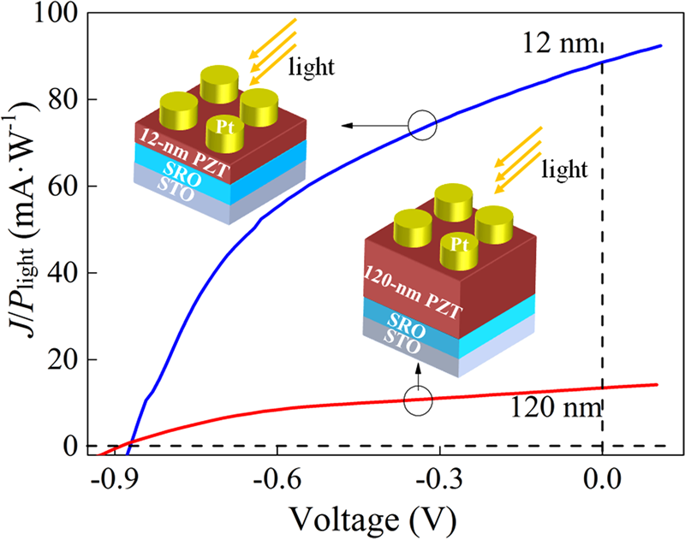NPG Asia Materials ( IF 8.6 ) Pub Date : 2019-04-26 , DOI: 10.1038/s41427-019-0120-3 Zhengwei Tan , Lanqing Hong , Zhen Fan , Junjiang Tian , Luyong Zhang , Yue Jiang , Zhipeng Hou , Deyang Chen , Minghui Qin , Min Zeng , Jinwei Gao , Xubing Lu , Guofu Zhou , Xingsen Gao , Jun-Ming Liu

|
Achieving high power conversion efficiencies (PCEs) in ferroelectric photovoltaics (PVs) is a longstanding challenge. Although recently ferroelectric thick films, composite films, and bulk crystals have all been demonstrated to exhibit PCEs >1%, these systems still suffer from severe recombination because of the fundamentally low conductivities of ferroelectrics. Further improvement of PCEs may therefore rely on thickness reduction if the reduced recombination could overcompensate for the loss in light absorption. Here, a PCE of up to 2.49% (under 365-nm ultraviolet illumination) was demonstrated in a 12-nm Pb(Zr0.2Ti0.8)O3 (PZT) ultrathin film. The strategy to realize such a high PCE consists of reducing the film thickness to be comparable with the depletion width, which can simultaneously suppress recombination and lower the series resistance. The basis of our strategy lies in the fact that the PV effect originates from the interfacial Schottky barriers, which is revealed by measuring and modeling the thickness-dependent PV characteristics. In addition, the Schottky barrier parameters (particularly the depletion width) are evaluated by investigating the thickness-dependent ferroelectric, dielectric and conduction properties. Our study therefore provides an effective strategy to obtain high-efficiency ferroelectric PVs and demonstrates the great potential of ferroelectrics for use in ultrathin-film PV devices.
中文翻译:

基于肖特基势垒效应的用于高效光伏的铁电薄膜变薄
在铁电光伏(PV)中实现高功率转换效率(PCE)是一项长期的挑战。尽管最近已证明铁电厚膜,复合膜和块状晶体都具有大于1%的PCE,但是由于铁电体的电导率根本较低,这些系统仍然遭受严重的重组。因此,如果减少的重组可能过度补偿光吸收的损失,则PCE的进一步改进可能取决于厚度的减少。在此,在12 nm Pb(Zr 0.2 Ti 0.8)O 3中证明了高达2.49%的PCE(在365 nm紫外线照射下)(PZT)超薄薄膜。实现如此高的PCE的策略包括将膜厚度减小到与耗尽宽度相当,这可以同时抑制复合并降低串联电阻。我们策略的基础在于以下事实:PV效应源自界面肖特基势垒,这是通过对厚度相关的PV特性进行测量和建模来揭示的。另外,肖特基势垒参数(特别是耗尽宽度)通过研究与厚度有关的铁电,介电和导电特性来评估。因此,我们的研究提供了一种获得高效铁电PV的有效策略,并证明了铁电在超薄膜PV器件中的巨大潜力。











































 京公网安备 11010802027423号
京公网安备 11010802027423号